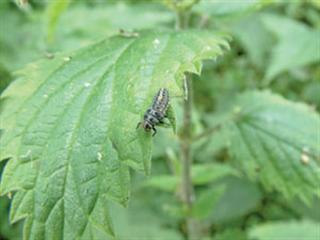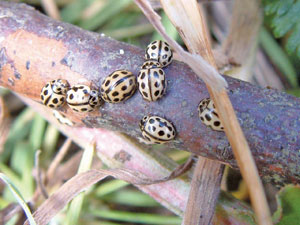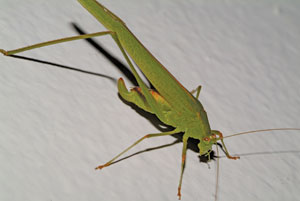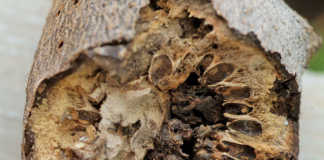
There are many different types of crop pests. Caterpillars, grasshoppers and locusts can easily be seen and dealt with. They feed on succulent leaves, often eating them down to the stem, or bite chunks out of the leaf before moving on to the next one. This is particularly destructive. The damaged leaves cannot produce food via photosynthesis, and eventually wither away and die.
Some pests suck the sap from stems. Twig wilters, for example, inject saliva that makes the sap easier to suck up. The plant then withers and dies above the point in the stem where the saliva was introduced. Other pests may be less obvious, because they live beneath the surface and attack plants from the roots upwards. A damaged root system has difficulty absorbing the water and nutrients needed for plant growth.
Biological control of insect pests involves using other insect species, called ‘biological control agents’. Although many local farmers think this method is mainly for emerging farmers, using insects as control agents in the US is an industry worth $100 million a year.
As farmers in Africa, we’ve barely started tapping into this form of pest control. In fact, very few even know what biological control is about. Simply put, it’s about manipulating the food chain to our advantage. Planted crops provide an abundance of food for pests. Predators should be encouraged to come in and control them.
Insect types
Predators:
- These are insects, such as ladybirds that eat other insects throughout their lives, in both larval and adult form.
Parasitoids:

Well camouflaged, preying mantids catch and eat moving insects.
- Similar to parasites, these insects kill the creature they settle in, which is why we like them. Many wasps fall into this category. They lay their eggs in the host insect. At hatching, larvae feed on the host and kill it. When using biological control agents, the pest species must be positively identified. Your extension officer should be able to help with this. The next step is to identify a natural predator that can be encouraged in large enough numbers to deal with the pest. It is important to make sure that the encouraged predator does not create greater problems for the farmer.
Biological control insects
Ladybirds:
- In both their larval and adult form, ladybirds eat aphids, leaf hoppers, mites, scale insects, small caterpillars and other pests. A single ladybird can consume up to 50 aphids a day.

Ladybirds are among the most welcome biological control agents.
Green lacewings:
- Although the adults are important pollinators, feeding only on pollen, the larvae eat many insects, including aphids, caterpillars, mealy bugs, mites, moth and butterfly eggs and other soft-bodied pests. They have big appetites and haven’t earned the name aphid lions for nothing.
Hoverflies:
- Adults feed on pollen and nectar, and are important pollinators. The larvae eat aphids and small caterpillars. As do ladybird larvae, a single larva can eat more than 50 aphids a day. The larvae are approximately 1cm long and resemble small bird droppings.
Katydids:
- Some katydids will eat aphids, caterpillars, insect galls and other pests.

Katydids have long hind legs and antennae. They are mainly nocturnal.
Assassin bugs:
- Efficient predators, they will eat virtually any kind of insect, of any size.
Preying mantids:
- Another useful insect predator.
Nematodes:
- These are minute worms that feed on soil-dwelling insects that attack the roots of plants and trees. However, they can be harmful to some vegetables, such as potatoes.
Ichneumonid wasps:
- They eat caterpillars.
Potter/mason wasps:
- Also eat caterpillars.
Tachinid flies:
- Possibly the most agriculturally important group of insects. These beneficial parasitoids attack a number of pest caterpillars, bugs and beetles.
Spiders:
- Because they vary in size, spiders can prey on insects ranging from aphids to locusts and grasshoppers. Apart from insects, there are other biological control agents, such as lizards, frogs and toads. Many of these eat the ground-dwelling pest species before they can reach the plant.

Spiders such as this banded orb-web spider predate on insects.
Predator attraction
One of the benefits of using predators to combat pests is that most of them occur naturally. Predators will remain in local areas as long as there is food, in the form of prey, available. There may be times when the predators need to be enticed. This can be achieved by planting the specific plants that act as their food source.
If the adult feeds on nectar or pollen, and the larvae on pests, planting a row of plants, such as sunflowers, along the edge of a land will bring in the adult insects. Leaving a few flowering trees along the borders of the land will have the same effect. It also serves to draw pests away from crops. Once the predators arrive, many may congregate on one plant, feeding on the associated pest. Gently remove a few and place them on other plants.
For example, you only need a couple of ladybirds or their larvae on a plant to control an aphid invasion. Spreading them around a bit is better than letting them find their next meal. A ladybird may fly away after a meal and not move from one plant to the next. In the end, it’s really very simple – actively encouraging one type of insect to feed on another can often be a much more effective means of control than other methods we have at our disposal, and has the benefit of causing less harm to the environment.
Beware of those chemicals
There may be times when we need to use insecticides on our crops. But whenever possible we should try to use one that won’t destroy beneficial insects. However, insecticides often kill as many beneficial insects as they kill pests. Don’t automatically assume that insects on the crop are pests. Instead, do some research to see if the insect can be used as a biological control agent.
Being in too much of a hurry to spray with insecticides can easily disrupt a balanced food chain. On the other hand, tinkering with the food chain by introducing biological control agents to feed on pests can actually make that food chain work in your favour.
Paul Donovan is a biologist who specialises in reptiles and insects. Contact him at [email protected].













